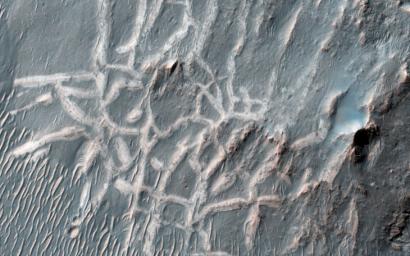
|
Many Small Interesting Ridges in Erythraea Fossa
- Click the image above for a larger view
- Full-Res JPEG (2880 x 1800) (747.4 kB)
- Full-Res TIFF (2880 x 1800) (15.6 MB)
Caption:

Map Projected Browse Image
Click on the image for larger version
These light-toned ridges are found in a large fracture located east of Holden Crater and form a curious box-like pattern.
A hair-line fracture runs along the axis of each ridge line . The overall pattern spans several hundred meters across and individual ridges are several meters wide. Scientists are not sure how they formed yet, but some possible explanations suggest that mineral-rich ground water flowed out of the hairline fractures and deposited minerals at or near the surface as the water evaporated.
In addition, these minerals may have formed a cement along the fractures, making these patterns more resistant to subsequent erosion by wind or other processes. The resulting cemented ridges then stand high above the surrounding plains.
Background Info:
HiRISE is one of six instruments on NASA's Mars Reconnaissance Orbiter. The University of Arizona, Tucson, operates the orbiter's HiRISE camera, which was built by Ball Aerospace & Technologies Corp., Boulder, Colo. NASA's Jet Propulsion Laboratory, a division of the California Institute of Technology in Pasadena, manages the Mars Reconnaissance Orbiter Project for the NASA Science Mission Directorate, Washington.
Cataloging Keywords:
| Name | Value | Additional Values |
|---|---|---|
| Target | Mars | |
| System | ||
| Target Type | Planet | |
| Mission | Mars Reconnaissance Orbiter (MRO) | |
| Instrument Host | Mars Reconnaissance Orbiter | |
| Host Type | Orbiter | |
| Instrument | High Resolution Imaging Science Experiment (HiRISE) | |
| Detector | ||
| Extra Keywords | Color, Crater, Map, Water | |
| Acquisition Date | ||
| Release Date | 2014-03-05 | |
| Date in Caption | ||
| Image Credit | NASA/JPL-Caltech/Univ. of Arizona | |
| Source | photojournal.jpl.nasa.gov/catalog/PIA18112 | |
| Identifier | PIA18112 | |
